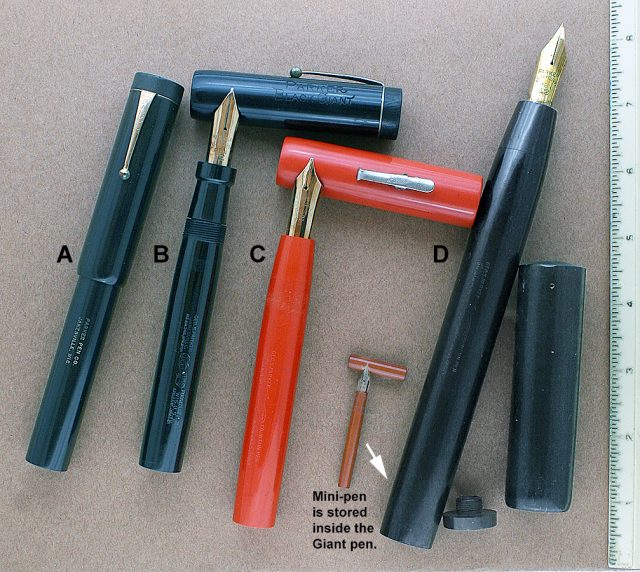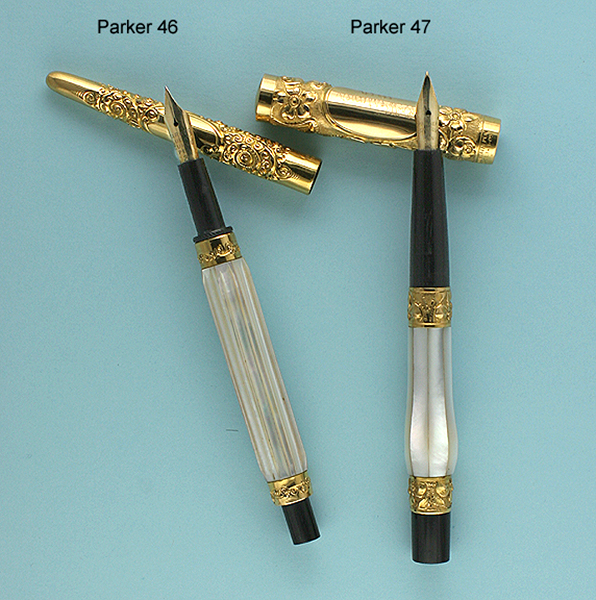
Early 20th Century Large Fountain Pens. L to R: Parker Black Giant, Parker Black Giant, Waterman Model 20, Parker Ultra Giant, with it’s “Spare Pen” which is stored inside the bottom of the barrel (note the screw-in plug which holds the baby pen inside the barrel).
According to Fountainpenday.com, “Taking place on the first Friday in November each year, Fountain Pen Day is celebrated by enthusiasts worldwide as a time to embrace, promote, and share the use of fountain pens.” The first Fountain Pen Day was celebrated in 2012, so 2021 marks its 10th anniversary. I thought that everyone would enjoy this article which is reproduced from the November 4th edition of South Florida Reporter, with their very kind permission.
Left Handed People Are More Likely To Use Fountain Pens Than Right Handed People

When you are taken to record the most important moments of your life, or turning words into poetry, only the elegance of a Fountain Pen will do. Fountain Pen Day reminds us of this, and encourages us to pick up a fountain pen and put our souls to paper.
- Ink required a new tool, and that tool was initially the dip quill pen, a bit of feather (usually goose) with a carefully cut nib to draw up the ink and transfer it to paper.
- This was such an amazing innovation that it stayed with us for a goodly long while, but ultimately a new creation was needed that didn’t require constant dipping, and that didn’t require constant recutting of the nib. So it was that the fountain pen came to exist in 1636, combining a wonderful reservoir of ink with a metal nib that didn’t require being recut constantly.
- The earliest form of a fountain pen was used by the Ancient Egyptians, in 3,000BC. They used a reed straw to write with ink made from vegetable gum and soot.
- The metal end of a Fountain pen is called nibs. These can be plain or decorative and they come in many sizes and materials.
- According to historical records in the 10th century and Egyptian Fatimid Califf called Al-Mu’izz Li-Din Allah asked artisans to make him a pen that wouldn’t leak over him. He was given a pen that had a reservoir of ink and it could be held upside down without leaking. This is considered by many to be the first example of a Fountain pen.
- The earliest recorded reservoir pen – a pen which held its own ink – dates from the year 953, and mentions were made of metal writing pens throughout the 17th and 18th centuries. It wouldn’t be until the early 18th century, however, that the term ‘fountain pen’ would be commonly used.
- Fountain pens can learn! If your fountain pen has a gold nib, this soft metal will slowly adjust to your style of writing over time. Therefore, the more you use your pen, the more unique your handwriting will become.
- The most expensive fountain pen in the world is the Aurora Diamante. Made from solid platinum and covered with two thousand precious stones, it’s worth approximately £922,000 (over $1,300,000)
- The headmaster of the Melville Junior School in Edinburgh, UK, has managed to raise academic performance at his school by insisting that all children be taught to use fountain pens from as young as 7 years old!
- The smallest fountain pen on record is called the “Nanofountain Probe”. It can write lines that are just 40 nanometres in width – that’s 40 billionths of a meter!
- Left handed people are more likely to use fountain pens than right handed people, which is due in part to the development of the rigid nib.
- Famous lovers of fountain pens include Arthur Conan Doyle, Ernest Hemingway, Neil Gaiman and HM Elizabeth II.
- 95 percent of the time, when a person receives a new pen, the first thing they write is their own name.
- Historians believe that the first writing instrument used by primitive humans was the finger. Eventually, man would begin to use metal and bone to create early forms of writing in the dirt.
- During the Middle Ages, man made quill pens from bird feathers to accommodate their writing needs. To convert the feathers to writing instruments, the feathered ends were split and sharpened. The ends were then dipped into ink.
- It is believed that the oldest fountain pen in our history was designed by a Frenchman, a Mr. Bion, in 1702.
- In the early 1800s, steel pens, which used steel tips called nibs, dipped into bottles of ink, became popular.
- Jacob Parker is believed to have patented the first self-filling fountain pen in 1831.
- Birmingham became the number one fountain pen nib manufacturer in the mid-nineteenth century. At the time, it was producing half of all of the fountain pens in the world.
- It was Lewis Waterman who developed a fountain pen that used an internal ink reservoir. This creation wasn’t patented by Waterman until 1884.
- By the 1890s, fountain pens began to be commonly filled using medicine droppers. Eventually, the droppers would be replaced with internal rubber sacs to hold ink.
- The first fountain pen that did not use an internal ink sac, was created by the Parker Pen Company in 1932.
- The knife that was used to make the slits in writing quills were very sharp, very small, and purposely made for the job. It was called a “penknife”. That’s where the name for the modern penknife originated from.
- Mont Blanc, the famous pen maker that supplies presidents and prime ministers with Fountain pens, are actually a German not French company like many believe.
- Staying with the Mont Blanc theme. The company is named after the tallest mountain in Europe: Mont Blanc which is in France.
Sources: Days of the Year Pen Heaven Notedian Every Fact Ever

Early Parker Pens. Left to Right: Parker Model 46, Parker Model 47. When all pens were Black Hard Rubber (Ebonite) pen manufactures adorned their pens with “overlays” made, for example, from gold, sterling silver, pearl, and abalone, both to add value (profit) and to differentiate them from plain pens.
